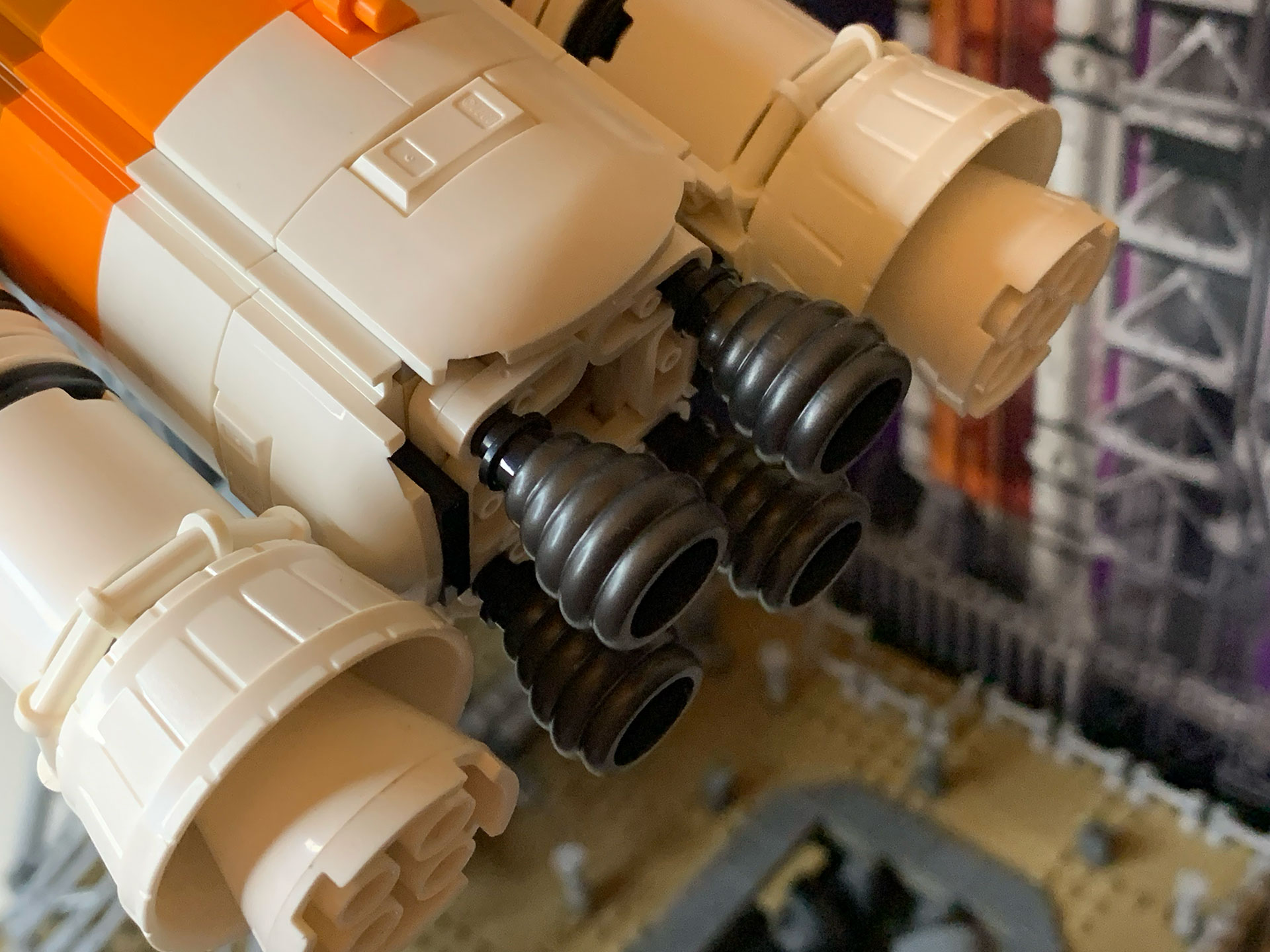
What do two dinosaur tails, four beehives, six segments of roller coaster track and 88 faucets have to do with a rocket designed to fly astronauts to the moon?
They are all among the repurposed parts, hidden details and "easter eggs" found when building the new Lego Icons NASA Artemis Space Launch System model, now lifting off from store shelves. The $259.99 (€259.99 or £219.99) set, which was released Saturday (May 18), includes both the rocket and its mobile launcher (ML), built up from 3,601 pieces.
Among those many plastic "bricks" are some creative new uses for older Lego sets' custom parts, as well as a few well-placed nods to the toy company's history. The set also packs in a slew of small details from the real Space Launch System (SLS), some of which Lego identifies in the kit's 370-page instruction book, but others assembled without explanation.
The real SLS first launched in November 2022 on NASA's uncrewed Artemis I mission around the moon. The flight marked the inaugural use of the first new mobile launcher built since the Apollo program. NASA's Artemis program will use the same infrastructure to send astronauts back to the moon as soon as late 2025 and aims to then land the first woman, first person of color and first non-American astronauts at the lunar south pole.
'Chutes' and 'ladders'
Although the Lego Icons NASA Artemis Space Launch System set is focused on the rocket, most of the build is spent assembling the more than two-foot-tall (70-cm) mobile launcher and, in particular, its support tower.
Beginning from outside the base of the ML and continuing up two levels and then on the deck at the bottom of the tower, Lego designers repurposed grilled slopes and Lego Technic racks to represent staircases. These flights of steps (along with the railings, represented using Lego water taps) provide a sense of scale.
"Unlike the real-life [ML], the Lego SLS platform has partly open sides showing interior details like pipes and staircases," reads one of notes included within the kit's instruction book.

One of the set's few moving features is that the umbilical arms reaching out to the rocket retract at the same time, just as they do during an actual launch. Although they are faithfully reproduced and a diagram appears the set's box, the individual arms are not labeled.
Beginning at the top, there is the crew access arm (partially constructed using Lego roller coaster track for gantry lattice work), which the astronauts use to board the Orion spacecraft; then the Orion service module umbilical, with its hoses (represented here by red and grey Lego dinosaur tails) that transfer liquid coolant and air to the European powerhouse and the interim cryogenic propulsion stage (ICPS) umbilical, which feeds fuel (liquid hydrogen), oxidizer (oxygen), purge air, gaseous nitrogen and helium, as well as electrical connections to the upper stage.
Next there is the core stage forward skirt umbilical, which provides air and nitrogen gas, as well as power and data; the vehicle stabilizer system, which holds the SLS in place when it is being moved (both in real life, such as during the rollout to the pad) and when moving the 1:144 scale model; and lastly, the core stage inter-tank umbilical, which vents gaseous hydrogen from the core stage.

At the base of the rocket, Lego has also recreated the aft skirt electrical umbilicals, aft skirt purge umbilicals and vehicle support posts, which service the two solid rocket boosters and supports the 5.75 million pounds (2,610 tons) that the Space Launch System weighs.
"Like in real life, the whole rocket rests on the skirts of the boosters," reads a note from Lego designer Hans Burkhard Schlömer in the instruction book.
Reused rocket parts
Just like the real SLS, which for its first several flights is reusing hardware left over from NASA's space shuttle program, the Lego Icons NASA Artemis Space Launch System has some custom parts and some adapted from prior sets.
"The Lego element used for the [RS-25] main engine nozzles was originally meant to depict a beehive but is called 'Mini hat no. 54,'" wrote Schlömer.

Two tail service mast umbilicals located on the deck of the ML are used to fill the core stage's tanks with liquid hydrogen and liquid oxygen, the propellant that will run through the engines during launch. Or, at least, that is what happens in reality.
From their exterior, the Lego tail service masts appear to be accurate miniatures of the actual hardware. Hidden inside them, though, is an "easter egg" that points to a different fuel source.
"A Lego rocket must be powered the Lego way, of course. The stacked rounded 1x2 plates inside the 'gas station' in front of the rocket have a long Lego history!" Schlömer wrote.
The white, red and green pieces are a nod to the logo colors for the fictional gas station brand Octan that was first introduced as part of the Lego City line more than 30 years ago. A similar, though more obvious easter egg was included with Lego's prior model of the SLS; designed for a younger builders, the 2022 Lego City Rocket Launch Center had white, red and green fuel lines and a tank labeled with an Octan logo.

Not to say that all of the SLS set's hidden details are in fact, hidden. One such part even kept its original purpose from when it was first produced.
"The cone element at the top of the boosters was already used in 1979 Lego Classic Space rockets (but had a solid stud with Lego logo)," noted Schlömer.
Follow collectSPACE.com on Facebook and on Twitter at @collectSPACE. Copyright 2024 collectSPACE.com. All rights reserved.







